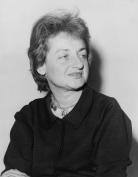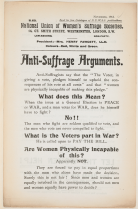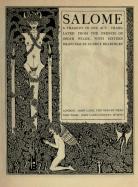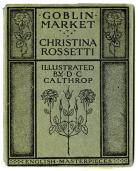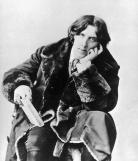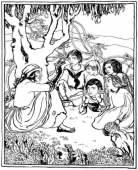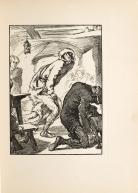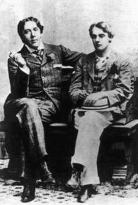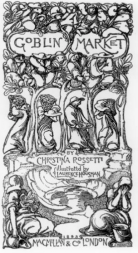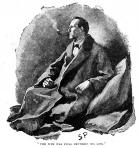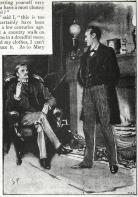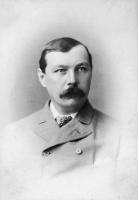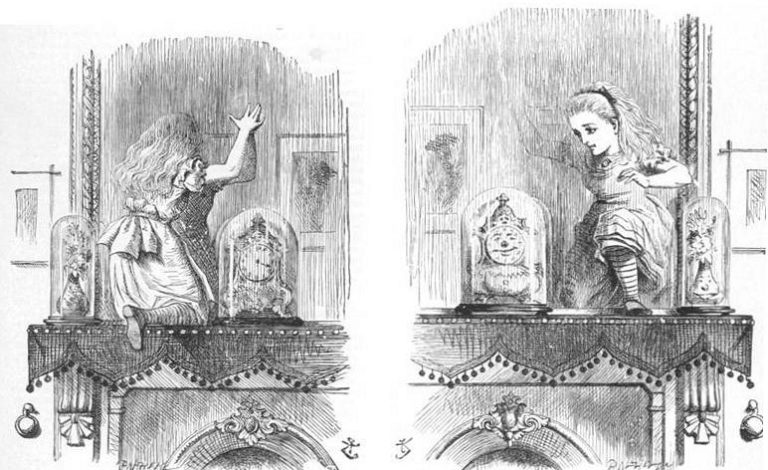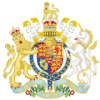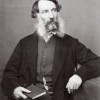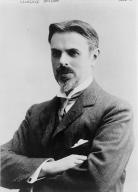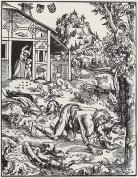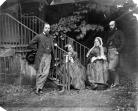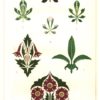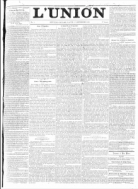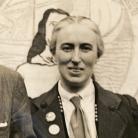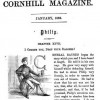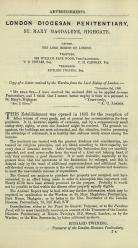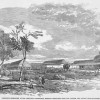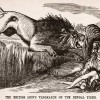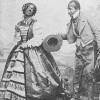Victorian Illustrated Books Timeline
Created by Lorraine Kooistra on Thu, 08/20/2020 - 16:52
Part of Group:
This Timeline documents events that are key to understanding contexts impacting the authors, artists, publishers, and readers of Victorian Illustrated books, in their own cultural moment and through to the present day. In addition to publishing events, these contexts include biographical, cultural, economic, political, social, and technological events.
Timeline
Chronological table
|
Date |
Event | Created by | Associated Places | ||
|---|---|---|---|---|---|
| 19 Feb 1963 |
Betty Friedan's The Feminine Mystique, PublishedInspired by French feminist, Simone de Beauvoir and her book The Second Sex (1949), Betty Friedan released her own critique on the condition of American society with The Feminine Mystique (1963). Friedan comments on how white women had once been active participants in the workforce as independent women during the 1920s and 30s. That independence had shifted when they were forced into domestic / private spheres as housewives and mothers after WWII. Women were seen rather than heard - from societal opinions (like education, the marketplace or reconstruction of redemption based on Christianity) to female sexuality being primarily for consumption i.e., Playboy magazines. These are often preordained, patriarchal Victorian ideals of gender roles based on chastity and obedience easily associated with Christina Rossetti's Goblin Market. Thus, The Feminine Mystique sparked conversations on women's rights, gender equality and female agency to challenge patriarchal orders. It also inspired the eventual legal victories in support of women and the creation of the National Organization of Women (NOW) in 1966, with current headquarters in Washington D.C. At the time of the sexual revolution between 1960s and 70s, this book plays a vital role in upturning the preconceptions of women being docile. While demanding sexual liberation, women also wanted to be respected / acknowledged as unrepressed, sexual beings - not for the pleasure of men, but for themselves. Principle Source(s): Fallen or Forbidden: Rossetti’s Goblin Market |Betty Friedan Wikimedia image |Womenshistory.org | Sexual Revolution in the US during the 1960s |
Alicia Beggs-Holder | |||
| circa. 1911 to circa. 1914 |
Feminist Movement and Goblin MarketGoblin Market was written by Christina Rossetti and originally published in 1862. Since then, it has gone through many reprints and changes. The reprint in 1912, while published after Rossetti’s death, was still released at a time of great change for women. During this time, the Suffragette movement was up and well in London. During the year of this edition’s release, the Labour Party became the first political party to include female suffrage in their manifesto. While this reprint could easily be tossed aside as just another children’s poem, the protagonists encounter sexually suggestive situations. This, and other 20th century adaptations of this poem, have opened the poem to Feminist, Queer, and New Historicist critiques. During this time of the Suffragette movement, there was a big movement for the rise of women in politics and positions of power. This was a voting year as well in the US and, for the first time, all presidential candidates looked at women as important to a victory rather than a passing thought. And, of course, at this time Tarrant releasing a reprint of a feminist poem with female protagonists will have an effect, whether intentional or not. All through the streets of London, women were marching for their rights to participate, to have a vote. Sources: Paula Bartley, Votes for Women, 1860-1928 (Oxon, 2003), p. 85. British Library Learning. “Women’s Suffrage Timeline.” The British Library, 2018, www.bl.uk/votes-for-women/articles/womens-suffrage-timeline, https://www.bl.uk/votes-for-women/articles/womens-suffrage-timeline. |
Zeinab Fakih | |||
| 1907 |
Salome by Oscar Wilde, PublishedThis edition of Oscar Wilde’s Salome: A Tragedy in One Act, features sixteen provocative illustrations by Aubrey Beardsley. It was published by John Lane and the Bodley Head in London and New York in 1907. Beardsley’s illustrations are photomechanical line block reproductions in pen and ink in an Art Nouveau style. Illustrations are featured in full-page reproductions, adjacent to the text, and are characterized by black and white massed shapes. Beardsley’s illustrations provide a stylized, symbolic visual commentary to Wilde’s play. This edition succeeds Wilde’s original publication of Salome in 1894, which Wilde intended to have the play put on at the Palace Theatre in London. However, the play failed to debut as a result of the British Examiner of Plays’ censoring efforts due to the text featuring biblical characters and perverse notions of religion and sexuality. This scandal was furthermore compounded by Wilde’s 1895 public indecency trial, which significantly hindered not only Wilde’s career, but Beardsley’s as well because of the popular associations between them as a result of this text. Source: https://beta.1890s.ca/wilde_bio/ https://archive.org/details/salometragedyino00wildrich/page/n11/mode/2up |
Kyle Sarjeant | |||
| 1906 to 1906 |
Goblin Market by Christina Rossetti Published with Dion Clayton Calthrop’s Illustrations
|
Melissa Emanoilidis | |||
| 1901 |
Laurence and Clemence Housman Move into Pembroke CottageLaurence Housman and Clemence Housman spent much of their lives side by side. They attended school together and it naturally followed that they would pursue similar careers in the fine arts and literature. Their shared residence at No. 1 Pembroke Cottage in Kensington became the centre of their activity in the Women's Suffrage Movement. Kensington had a reputation for their suffrage activity. The Kensington Society encouraged feminist discourse, giving way to two branches of the National Union of Women's Suffrage Societies (NUWSS) as well as a branch of the Women's Social and Political Union (WSPU), a militant suffrage group. Laurence and Clemence Housman began supporting the WSPU in 1908. Their cottage quickly became a centre for suffrage movements. In 1910, the Suffrage Atelier (founded by Laurence and Clemence) made Pembroke Cottage its headquarters. A WSPU banner was made there, suffragettes boycotting the 1911 census took refuge at the cottage, and suffrage craft work was produced there. The Housman's background in the fine arts and literature proved useful to promoting the women's suffrage agenda. |
Nicole Bernard | |||
| 30 Nov 1900 |
Oscar Wilde's DeathAfter a long two years, Oscar Wilde was released from prison in 1897 which left him impoverished and exiled resulting in the decision to move to Paris. The last few years of his life were not the best due to being poor and not having a place he could call home; he only wrote one work at the time. On November 30th 1900 Oscar Wilde passed away due to meningitis, which put an end to his life in just five days. Many speculated how Wilde contracted the disease with some saying it stemmed from syphilis while many others thought that was absurd as they believed the meningitis may have resulted due to a faulty surgery he underwent or an infection he had in his ear due to an injury he got in prison. Despite the constant speculation, the day of his death was a loss for many nonetheless. |
Tatiana Batista | |||
| 1899 |
Annancy Stories PublishedThis collection of stories, titled the Annancy Stories, is written and illustrated by Pamela Colman Smith. It was published by R.H. Russell New York in 1899. This work is a collection of stories from Jamaican Folklore which includes 26 full pages of illustrations and numerous textual decorations. The illustrations were in black and white, however her hand coloured prints showed signs of great promise as mentioned in an 1899 article. Furthermore, her illustrations mirror common bold caricature drawings in which she is able to give equal authority to both her texts and visuals. Although published during the Victorian period, Annancy Stories is notable for its non-victorian and non-British illustrations. Instead, the collection of stories use the relationship of text and image in order to emphasize on themes of West Indies Folklore. The style of the illustrations are not commonly found in Victorian Literature which makes this book unique to the time period. The "Anansi" is spider-like Jamaican Folklore figure that is reoccuring in the book and is considered a god of all knowledge of stories. Pamela uses this figure in order to further distinguish her work from other works of the time period. Annancy Stories was published alongside four other books from Smith, which were reviewed very positively. Although critics noted that her works were not well known, they felt Smith’s work held great potential for the future. Source: Denisoff, Dennis. “Pamela Colman Smith (1878-1951),” Y90s Biographies, edited by Dennis Denisoff. Yellow Nineties 2.0, General Editor Lorraine Janzen Kooistra, Ryerson University Centre for Digital Humanities, 2019, https://1890s.ca/smith_bio/ Contributed to by: Mark Dasilva, Yousef Farhang, and Patricia Lucreziano |
Patricia Lucreziano | |||
| Jan 1896 |
The Were-Wolf Published by The Bodley HeadThe Were-Wolf was written by Clemence Housman and originally illustrated by Everard Hopkins for the December 1890 Christmas number of the Atalanta periodical literary magazine. Aterwards, the 1896 edition was illustrated through a collaborative effort between Housman and her brother Laurence Housman. Clemence wood-engraved the six featured illustrations and title page and bindings for the book following the designs created by her brother. The book was published through Housman’s connection to publisher John Lane at The Bodley Head. The Were-Wolf is a Gothic work of fiction with a total of 6 illustrations in the second published edition of the book, including the decorated title page, and an illuminated initial which were all designed by Laurence Houseman. Initially Clemence Housman created “The Were-Wolf” to entertain her wood engraving class, it was initially received as a feminist text due to the central character being female and a were wolf . The first edition was published in 1890 with illustrations done by Everard Hopkin. She later collaborated with her brother Laurence Housman and published the second edition in 1896 where she herself did the wood engravings for the title page along with the illustrations. By: Mila, Alicia and Andrea Source: Housman, Clemence. The Were-Wolf (1896), illustrated by Laurence Housman; wood-engraved by Clemence Housman. Were-Wolf Digital Edition edited by Lorraine Janzen Kooistra et al, COVE Electronic Editions, 2018, https://editions.covecollective.org/edition/were-wolf |
Andrea Aguiar | |||
| Nov 1895 |
House of Joy PublishedThe House of Joy was written and illustrated by Laurence Housman in 1895 and published by Kegan Paul, Trench Trubner & Co. The House of Joy is a collection of adult fairy tales and were often given as Christmas gifts. Housman's original method of illustration was pen and ink and was later reproduced for the public masses through line-blocking, which was a type of photo processing technology that was popularized in the 1890s. The book consists of 10 illustrations at the beginning of each tale and each story is dedicated to a woman or girl. The illustrations in the House of Joy are proleptic in nature, meaning they anticipate events. For example, the tale, The Prince With the Nine Sorrows, on page 16, illustrates a boy lying on the grass looking up in distress at 9 beautiful maidens. Right away the reader can make the connection between the title and anticipate that the image is showing what is to happen later in the story with this prince. Housman cleverly uses both images and text to engage and deepen the readers understanding of his work. Information gathered came from the primary source, House of Joy, 1895. By Alessia Dickson, Alicia and Melissa.
|
Alessia Dickson | |||
| 25 May 1895 |
Oscar Wilde SentencedOscar Wilde was found guilty of gross indecency and sentenced to two years hard labour on 25 May 1895. |
Lorraine Kooistra | |||
| 6 Apr 1895 |
Oscar Wilde ArrestedOscar Wilde was arrested in London and charged with the crime of gross indecency. The arrest came after Wilde lost a libel case against the Marquess of Queensberry, who accused him of having sex with men, which was then a criminal offense in England. Wilde lost the libel case because the judge deemed the evidence supported the Marquess's claim. In fact, WIlde's lover at the time, Lord Alfred Douglas, was the Marquess's son, the translator of his controversial play, Salome. At the time of his arrest, Wilde was carrying a yellow-covered French novel, mistakenly identified in the press as The Yellow Book. This misnomer resulted in the firing of Aubrey Beardsley as the magazine's art editor. Beardsley was associated with Wilde through his decadent illustrations for the play, Salome, but was not otherwise involved with the author. |
Lorraine Kooistra | |||
| Feb 1894 |
Illustrated English edition of Salome PublishedOscar Wilde first published Salomé in French in 1893. The story of the play is loosely based on the biblical passage that tells of John the Baptist's beheading after the daughter of Herodias dances for Herod. In Wilde's version, it is Salome, not her mother, who demands John's head on a silver platter. The first English edition, Salome: A Tragedy in One Act,was published in 1894 by The Bodley Head and illustrated with 10 full-page pictures by Aubrey Beardsley. Both the text and its images were controversial. The publisher, John Lane, suppressed some of Beardsley's illustrations; these were later published in the 1907 edition. Oscar Wilde did not like Beardsley's illustrations. "My Herod is like the Herod of Gustave Moreau--wrapped in his jewels and sorrows. My Salomé is a mystic, the sister of Salammbô, a Sainte Thérèse who worships the moon; dear Aubrey's designs are like the naughty scribbles a precocious schoolboy makes on the margins of his copybooks" (Jean-Paul Raymond and Charles Ricketts, Oscar Wilde: Recollections). |
Lorraine Kooistra | |||
| 1893 |
Goblin Market by: Christina Rossetti with Illustrations by Laurence HousmanThe edition of Christina G. Rossetti's Goblin Market that includes illustrations by Laurence Housman was published originally in 1893, about thirty years after the edition that included Dante Rossetti's illustrations. It was known that Housman closely studied the illustrations of Dante Rossetti before creating his twelve full page images and several textual decorations. This is extremely noteworthy because of the direct comparisons that can be made between both Gabriel Rossetti and Laurence Housman’s editions. Dante Rossetti's edition only contained two full page images, whilst Laurence Houseman's contained twelve. Housman was the one to create a fully illustrated version of the poem, notably, thirty years later. Christina Rossetti had actually requested Housman to refer to her brothers’ illustrations of the goblins. With that being said, it presents to us that Dante Rossetti’s illustrations were the illustrations that Christina herself resonated with the most and what she felt reflected her poem the best. Thus, leading Housman to study Dante’s work in the original publication and illustrations to then create a new edition, fully illustrated, in Christina’s lifetime in which fit her vision. Source: Kooistra, Lorraine Janzen. Christina Rossetti and Illustration : A Publishing History, Ohio University Press, 2002. ProQuest Ebook Central, https://ebookcentral-proquest-com.ezproxy.lib.ryerson.ca/lib/ryerson/det....
|
Patricia Lucreziano | |||
| 1893 |
Pamela Colman-Smith Enrolls at the Pratt InstituteIn 1893, at the age of 15, Pamela Colman-Smith moved to Brooklyn, New York to enroll in the recently established Pratt Institute. The Pratt Institute is a private university founded by oil tycoon Charles Pratt, whose goal was to provide affordable education to working-class men and woman. Here, Colman-Smith studied art for four years before eventually leaving the institute without a degree in 1897 (partly due to on-and-off illnesses she suffered throughout her studies). It is at Pratt that Colman-Smith studied under Arthur Wesley Dow, a highly influential artist and educator who served as chairman of the university. Under Dow's guidance, Colman-Smith was introduced to the cutting-edge art movements dominating Western art at the time -- namely, Art Nouveau and Symbolism, both of which are seen to have influenced Colman-Smith's later work. Dow's own aesthetic theories had a profound influence on Colman-Smith's illustrations, particularly his attempt to incorporate elements of Asian art into Western painting (Colman-Smith, in her own theoretical writings, employed Dow's conception of beauty in art, for example). After leaving Pratt, Colman-Smith found work as an illustrator, eventually illustrating for such renowned writers as W.B. Yeats and Bram Stoker. |
Justin Hovey | |||
| 14 Oct 1892 |
The Adventures of Sherlock Holmes PublishedThe Adventures of Sherlock Holmes is one of literature's most famous recurring characters and a staple in the mystery genre. Arthur Conan Doyle has crafted a series that has stood the test of time and cemented its place amongst literary canon. The Adventures of Sherlock Holmes was published on October 14th, 1892, by The Gresham Press and George Newnes as a collection of short stories containing over 100 images. In essence, Doyle’s work has been responsible for creating much of the conventions that are a staple of the mystery genre. Between 1887 and 1927, Doyle wrote four novels and fifty-six stories with Sherlock Holmes. All the short stories appeared first in The Strand magazine before eventually being published as book editions. Without question Sherlock Holmes is a classic literary figure, and his iconic look has played a large role in his historical staying power. Sidney Paget, the illustrator responsible for the work in The Adventures of Sherlock Holmes, played an essential role in the creation of the Sherlock Holmes that we know today. Paget used a photomechanical half-tone method of illustration that is directly responsible for the sketch style that defined the series’ illustration. What’s significant about Paget’s illustration is that he created these drawings entirely based on Doyle's references to Holmes’ dress. This is important because it speaks to the notion of the artist and author as separate bodies, each interpreting the text in their own individual way. Source: victorianweb.org Submitted by: Simon Mancuso, Alexandra Monstur and Marina Arnone |
Marina Arnone | |||
| Jul 1891 |
"A Scandal in Bohemia" Published in Strand MagazineThe first story in The Adventures of Sherlock Holmes collection is published in Strand Magazine. After two novels starring Holmes and his partner Dr. Watson, this is Sir Arthur Conan Doyle’s first short story featuring the detective as well as his second publication in Strand. It also marks the first time Sidney Paget provides the illustrations for a Holmes story. Paget is hired by Strand Magazine to illustrate all of the Holmes stories in the collection. This first collaboration leads to a long-time partnership between Conan Doyle and Paget, with Paget going on to illustrate more than 350 images for one novel and 37 short stories. Paget and Conan Doyle’s partnership extended beyond just Holmes stories, with Paget providing hundreds of illustrations for Conan Doyle’s non-detectives works in the magazine as well. Conan Doyle’s stories and Paget’s iconic images made the Sherlock Holmes stories among the most popular of the Victorian era and created the blueprint for the sleuthing detective figure in mystery fiction for centuries. The popularity of these stories often led to issues of Strand Magazine featuring Holmes stories selling out. This resulted in frequent publications of Doyle’s works — including Holmes stories, other short stories, poems, articles, and interviews — being published in Strand Magazine until the final issue of the magazine was released in 1930. Primary Sources: Sidney Paget, The Victorian Web |
Fahimah Hamidavi | |||
| Dec 1890 |
The Were-Wolf Published in Atalanta: A Magazine for GirlsThe Were-Wolf was written by Clemence Housman and originally illustrated by Everard Hopkins for the December 1890 Christmas number of the Atalanta periodical literary magazine. The Were-Wolf is a Gothic work of fiction, and is often read as a feminst text. Initially Clemence Housman created “The Were-Wolf” to entertain her wood engraving class, it was initially received as a feminist text due to the central character being female and a were wolf. The publication in Atalanta magazine is crucial to a feminist reading - considering the fact that it was a magazine for women, the text itself containing a female werewolf character changes the way that it is read. By: Mila, Alicia and Andrea Source: Housman, Clemence. The Were-Wolf (1896), illustrated by Laurence Housman; wood-engraved by Clemence Housman. Were-Wolf Digital Edition edited by Lorraine Janzen Kooistra et al, COVE Electronic Editions, 2018, https://editions.covecollective.org/edition/were-wolf |
Andrea Aguiar | |||
| 1876 to 1882 |
Sir Arthur Conan Doyle’s Medical CareerIn 1876, Sir Arthur Conan Doyle began his medical career studying at the University of Edinburgh in Scotland. Here he met two professors who would later inspire his most famous protagonists. The character Professor George Edward Challenger was inspired by Professor Rutherford, an Assyrian man with a booming voice, broad chest, and thick beard. The character Sherlock Holmes was based on Dr. Joseph Bell, a Professor of Surgery, whose incredible deductive reasoning skills motivated Doyle to create a detective who used the same methods. It is during his medical studies that Doyle began writing short stories. His earliest surviving work of fiction, “The Haunted Grange of Goresthorpe,” was submitted to Blackwood’s Magazine, however, it was unsuccessful in achieving publication. “The Mystery of Sasassa Valley” was Doyle’s first published piece; it was published anonymously in Chamber’s Edinburgh Journal on September 6th, 1879. His first academic article, “Gelsemium as a Poison” was published in the British Medical Journal on September 20th, 1879. In 1880, during his studies, Doyle also worked as a medical assistant to help support his family financially. He graduated on October 22nd,1881 and enlisted as a doctor aboard a steamboat to Western Africa; the trip was extremely unpleasant, with Doyle falling severely ill in Lagos. A brief and unsuccessful partnership in 1882 pushed Doyle to open his own practice of ophthalmology in Southsea, England. This practice was too unsuccessful; with very little clientele, Doyle was left ample time to continue his fiction writing.
Principal source: https://www.arthur-conan-doyle.com/index.php/Biography |
Payton Flood | |||
| 27 Dec 1871 |
Publication of Lewis Carroll's Through the Looking Glass Articles |
David Rettenmaier | |||
| 9 Aug 1870 |
Education Act of 1870
ArticlesFlorence S. Boos, “The Education Act of 1870: Before and After” |
David Rettenmaier | |||
| Jun 1870 |
Civil suit against Edward John Eyre nullified
Articles |
David Rettenmaier | |||
| 10 Oct 1869 |
Exhumation of Dante Gabriel Rossetti's manuscriptsOn 10 October 1869, Dante Gabriel Rossetti had the manuscripts that he had previously buried with Elizabeth Siddal exhumed. Image: "Praise and Prayer" manuscript, one of three surviving leaves from the manuscripts Rossetti buried with his wife on 17 February 1862 in Highgate Cemetary. The original is in the Houghton Library, Harvard University, Cambridge, Mass. (MS Eng 769). |
Jerome McGann | |||
| Jun 1868 |
Edward John Eyre acquitted
Articles |
David Rettenmaier | |||
| 1 Dec 1867 |
Clerkenwell Prison bombingA bomb planted by Irish Fenians at Clerkenwell Prison in London exploded on 13 December 1867, killing over a dozen people and injuring many more. Related Articles |
David Rettenmaier | |||
| 15 Aug 1867 |
Second Reform Act
ArticlesJanice Carlisle, "On the Second Reform Act, 1867" Related ArticlesCarolyn Vellenga Berman, “On the Reform Act of 1832″ Elaine Hadley, “On Opinion Politics and the Ballot Act of 1872″ |
David Rettenmaier | |||
| 27 Mar 1867 |
Edward John Eyre indictment hearing
Articles |
David Rettenmaier | |||
| 11 Feb 1867 |
Trafalgar Square demonstrationMajor Reform League march and demonstration in Trafalgar Square, London on 11 February 1867. Related Articles |
David Rettenmaier | |||
| 1 Feb 1867 |
Fenians attack coast guardIrish Fenians attack a coast guard station in County Kerry, Ireland, seizing arms and attacking policemen; authorities prevent a similar attack by Fenians on Chester Castle in Western England. Related Articles |
David Rettenmaier | |||
| 2 Jul 1866 |
Hyde Park demonstrationHyde Park Demonstration of the Major Reform League on 23 July 1866. After the British government banned a meeting organized to press for voting rights, 200,000 people entered the Park and clashed with police and soldiers. Related ArticlesPeter Melville Logan, “On Culture: Matthew Arnold’s Culture and Anarchy, 1869″ |
David Rettenmaier | |||
| Dec 1865 |
“Jamaica Committee”
Articles |
David Rettenmaier | |||
| Nov 1865 to Nov 1866 |
Cholera EpidemicThe last cholera epidemic is conventionally termed “of 1866” as that was the period of the highest mortality. The epidemic arrived in Britain in September 1865 and ended in November 1866. Articles |
David Rettenmaier | |||
| 11 Oct 1865 |
Morant Bay Rebellion
Articles |
David Rettenmaier | |||
| 18 Jul 1865 |
Birth of Laurence HousmanLaurence Housman was born on July 18, 1865 in Bromsgrove, England, the sixth of Edward and Sarah Jane Williams Housman's seven children. He was exceptionally close with his older sister Clemence Housman (1861-1955). Their eldest sibling was the poet and classical scholar A.E. Housman (1859-1936). Laurence attended art school— primarily book arts— in London with Clemence, who mastered wood engraving. His exceptional version of Christina Rossetti's Goblin Market (1893) led to his involvement at The Bodley Head, where he designed and illustrated many books of poetry and fiction. Here, he also collaborated with Clemence, making illustrations which she would then engrave, including those for her story,The Were-Wolf, published in1896. By 1900, declining eyesight ended his illustration career, but he was also a prolific and controversial playwright. Laurence Housman lived as an outspoken suffragist, pacifist, socialist, and homosexual advocate for sexual tolerance and freedom (Oakley, Inseparable Siblings). |
Hayley Horvath | |||
| 1865 |
S. Baring-Gould publishes “The Book of Were-Wolves”The Book of Were-Wolves by the Reverend Sabine Baring-Gould is a collection of werewolf folklore and mythology originally published in 1865 by Smith, Elder & Co. The text investigates the various mentions of werewolves from “ancient writers of classic antiquity,” “Northern Sagas,” and “mediæval authors,” to create a “sketch of modern folklore relating to Lycanthropy” (Baring-Gould 6). Born in 1834 in Devon, England, Baring-Gould was a theologian, hagiographer, novelist, linguist, and collector of folk songs, as well as a composer of hymns, his most famous being “Onward Christian Soldiers.” He was ordained as an Anglican Priest in 1865. Baring-Gould’s uniquely diverse talents are represented in The Book of Were-Wolves, as various chapters pull from oral traditional tales, folk songs, historical accounts, and medical documentation that link lycanthropy to the real world. Baring-Gould attempts to associate lycanthropy with cannibalism, spiritual possession, and madness to reveal “that under the veil of mythology lies a solid reality, that a floating superstition holds in solution a positive truth” (Baring-Gould 6). This text would have been an excellent reference for Clemence Housman when writing The Were-Wolf. |
Michael Seravalle | |||
| 6 Oct 1863 |
Lewis Carroll Photographs the Rossetti FamilyThis photograph of the Rossetti family was taken by Charles Luttwidge Dodgson, later known as Lewis Carroll, the author of the Alice books. An Oxford mathemetician, Dodgson was also an avid amateur photographer. In the fall of 1863, Dodgson took a series of photographs in Dante Gabriel Rossetti's back garden at 16 Cheyne Walk in London. This photograph shows Dante Gabriel Rossetti standing, at left; his sister, the poet Christina G. Rossetti, seated on the step; their mother, Frances Lavinia Rossetti, seated next to her; and another sibling, William Michael Rossetti, standing at right. Missing from the picture is the other Rossetti daughter, Maria Francesca. The Rossetti children are in their early to mid thirties in this photograph. At the time the photograph was taken, Dante Gabriel was a celebrated painter and a founding member of the Pre-Raphaelite movement; Christina Rossetti was a critically admired poet and author of Goblin Market and Other Poems (1862), which her brother had illustrated; and Lewis Carroll had written, but not yet published, one of the most famous illustrated books of the Victorian period, Alice's Adventures in Wonderland (1865), with numerous wood-engraved pictures after John Tenniel's designs. Carroll admired both Christina's poetry and Dante Gabriel's design for her book, and had been reading Goblin Market on the famous day he took the Liddell sisters for an outing on the river and began telling them the story of "Alice's Adventures Underground," July 4, 1862. |
Lorraine Kooistra | |||
| 15 Aug 1862 |
Cage CrinolineAt the peak of the cage crinoline fad, a single issue of the London Evening Standard (15 August 1862) included a report of a young woman’s death caused by a crinoline fire and an advertisement touting the monarch-approved Thomson’s prize-winning “Crown” model. ArticlesRebecca N. Mitchell, “15 August 1862: The Rise and Fall of the Cage Crinoline” |
David Rettenmaier | |||
| Mar 1862 |
Goblin Market and Other Poems PublishedGoblin Market is a Victorian narrative poem written by Christina Rossetti and illustrated by her brother Dante Gabriel. Rossetti felt that the collaboration with her brother was crucial to her overall work, that she deliberately delayed the publication until Dante Garbiel’s illustrations were ready for press. He designed a total of two illustrations, the frontispiece and title page, for The Goblin Market. Both images were pressed using wood engravings, evoking the pre-raphaelite designs popular during the 1860’s. The passages appeal to the senses through vivid descriptions of colours, textures, aromas and taste. Critics assigned the poem to various general categories over the following decades and throughout the twentieth century. It was first viewed as a fairytale but was later viewed as an allegorical piece. Feminist critics often analyzed the poem’s social commentary on gender relations and the relationship between two sisters. Later in the nineteenth century, readers, reviewers, illustrators, and composers began to focus on the poem’s powerful aesthetic qualities. Its sensuous patterns, religious images, and social implications inspired the focus of school studies and as well as musical settings and performances. The power of its visual images, and the two wood-engraved designs by Dante Gabriel Rossetti in the poem’s first publication, turned to evoke numerous artistic interpretations, ranging from stained glass windows to gift books.
Curated by Kisha Rendon, Joseph Pereira, and Payton Flood Public Domain; source: COVE Goblin Market edition by Lorraine Janzen Kooistra, Antony Harrison |
Payton Flood | |||
| 17 Feb 1862 |
Burial of Elizabeth SiddalElizabeth Eleanor Rossetti (formerly Elizabeth Siddal) was buried on 17 February 1862 in Highgate Western Cemetary in the Rossetti family plot. Dante Gabriel Rossetti placed "Dante at Verona," "Love's Nocturne" and other manuscript poems in her coffin before interment. Image: the Rossetti family grave where Elizabeth Siddal is buried (courtesy of The Victorian Web). |
Dino Franco Felluga | |||
| 11 Feb 1862 |
Death of Elizabeth SiddalElizabeth Eleanor Rossetti (formerly Elizabeth Siddal) died of a laudanum overdose at 7:20 a.m. on 11 February 1862 at 14 Chatham Place. Image: Elizabeth Siddal self-portrait. This is a faithful photographic reproduction of a two-dimensional, public domain work of art. |
Dino Franco Felluga | |||
| 1862 |
Christopher Dresser, The Art of Decorative Design
Image: Plate II from Dresser, The Art of Decorative Design (1862). Courtesy of the Department of Special Collections, Stanford University Libraries. ArticlesIrena Yamboliev, “Christopher Dresser, Physiological Ornamentist” Related ArticlesMorna O’Neill, “On Walter Crane and the Aims of Decorative Art” Wendy S. Williams, "‘Free-and-Easy,’ ‘Japaneasy’: British Perceptions and the 1885 Japanese Village" Siobhan Carroll, "On Erasmus Darwin’s The Botanic Garden, 1791-1792" |
David Rettenmaier | |||
| circa. 1862 |
First Black Newspaper in the SouthL'Union, the first Black Newspaper in the South, is published in 1862. The newspaper expressed oposition to white racism and asserted their rights to self-determination. It was not easy for Blacks to publish newspapers in the south at this time. Many newspaper were short-lived and copies were not preserved for historians. |
Kassidy Montuoro-Germann | |||
| 23 Nov 1861 |
Birth of Clemence Annie HousmanClemence Annie Housman was born in Bromsgrove, England, on November 23, 1861, to Edward Housman and Sarah Jane Williams Housman. Her name was chosen because her birth day fell on Saint Clement’s Day in the liturgical calendar; notably, Clemence was fascinated by sainthood throughout her life. Clemence was the third child and oldest girl in a family of seven children, the eldest of whom was the well-known poet, A .E. Housman (1859-1936). Clemence was very close to the second youngest of her siblings, Laurence (1865-1959), with whom she lived and worked her entire life. In addition to writing novels, Clemence was a wood engraver and an activist in the feminist movement for female suffrage.(Oakely, Inseperable Siblings) |
Lorraine Kooistra | |||
| 1 Jan 1860 |
Cornhill Magazine founded
Articles |
David Rettenmaier | |||
| 1859 |
1859- Christina Rossetti's experience in the "Magdalene Asylum"There was discourse about the place for women within the Victorian Era. Women were not seen as equal to men and due to this were neglected from the work force and not credited as equals. They were pegged as property for men and did not belong to themselves. Though Christina Rossetti was a well established poet, she was still a woman. As a youth she had volunteered at the "Magdalene Asylum" which was known for housing prositutes and women who were not seen as appropriate. This had greatly influenced her poem Goblin Market . Considering this time period in regards to feminism it is known that the women were not treated approprietly within the asylum. Christina Rossetti’s poem Goblin Market shares tones of feminism by making her poem centre around two female characters, a woman who is tempted by masculine goblin figures and a strong headed woman who fights for her family. A story about women written by women during the Victorian Era is very important as it speaks to the movement happening for women rights and equality for all throughout England.The "Magdalene Asylum" is likely where Christina Rossetti picked up many of the tones found throughout the poem and encouraged her to write about women. Women were fighting for equality and there was a wave of literature coming from female writers that help introduce the world to feminism through their work. Sources Thor, Jowita. "Religious and Industrial Education in the Nineteenth-Century Magdalene Asylums in Scotland." Studies in Church History, vol. 55, 06/01/2019, pp. 347-362, doi:10.1017/stc.2018.4. |
Alicia Puebla | |||
| 1859 to 1870 |
Christina Rosetti Volunteers at the London Diocesan PenitentiaryEarly in the year of 1859, Christina Rosetti began volunteering at the London Diocesan Penitentiary, otherwise known as the Highgate Penitentiary, due to its location within the district of Highgate, London. As denoted by an advertisement for the house from an 1860 edition of the newspaper, The Morning Post, this penitentiary was an "establishment for fallen women of every grade." More specifically, many of the women under its care had previously worked as prostitutes. The reform house inculcated these women with religious principles and fitted them with the abilities to complete domestic tasks expected of the typical Victorian woman, in an attempt to reform and reintegrate them back into English society. What is of note concerning Rosetti's work volunteering with this organization is that it is concerned entirely with reinventing the fallen women - essentially, women who have used sex work as a means of income. Instead of ostracizing them (as was common within Victorian society, due to prostitution being seen as a moral ill), the penitentiary was attempting, in a sense, to redeem these women. With this in mind, it is easy to recognize the religious parallels between Rosetti's volunteer work, and her work "Goblin Market", which, at its most basic interpretation, is a poem about a sister saving her sibling, who has committed a grave sin by consuming forbidden goblin fruit. Principle Sources: |
Alexandra Monstur | |||
| 1 Oct 1857 |
Westminster Review review of Tennyson’s PoemsOn 1 October 1857, the Westminster Review reviewed Tennyson’s illustrated Poems; Art Catalogues of the Art Treasures Exhibition; and John Ruskin’s Elements of Drawing. Related Articles |
David Rettenmaier | |||
| 28 Aug 1857 |
Matrimonial Causes Act of 1857
ArticlesKelly Hager, “Chipping Away at Coverture: The Matrimonial Causes Act of 1857″ Related ArticlesRachel Ablow, “‘One Flesh,’ One Person, and the 1870 Married Women’s Property Act” Jill Rappoport, “Wives and Sons: Coverture, Primogeniture, and Married Women’s Property” |
David Rettenmaier | |||
| 22 Aug 1857 |
The Illustrated London News story on Meerut revolt
Related Articles |
David Rettenmaier | |||
| 22 Aug 1857 |
John Tenniel’s “The British Lion’s Vengeance on the Bengal Tiger”
Related Articles |
David Rettenmaier | |||
| Aug 1857 |
Christy Minstrels performed at St. James’s Theater
Related Articles |
David Rettenmaier |

